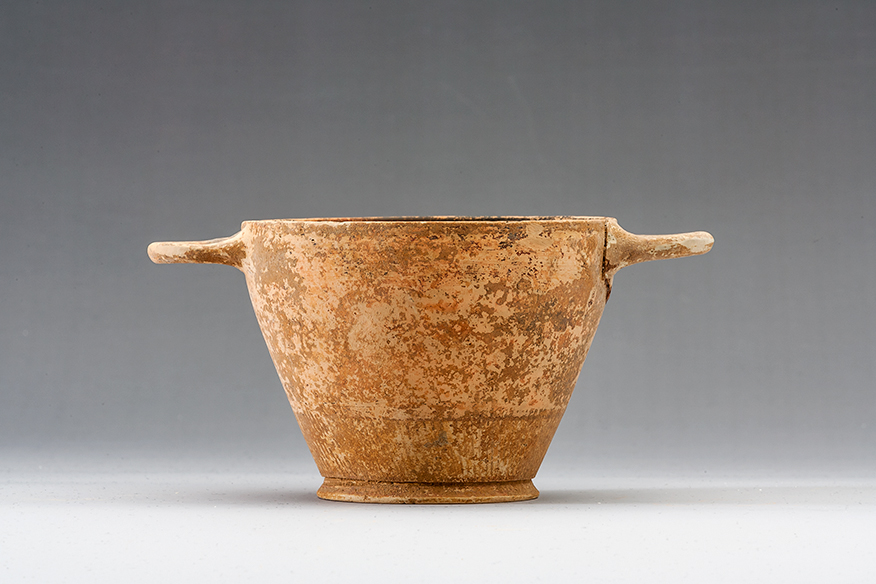Acquisition number: 1990.06
Corinthian Kotyle.
Reconstructed from fragments but without serious repainting. The surface is worn in places and there is some incrustation present. Cream-buff Corinthian clay, well fired and with a smooth hard finish. The handles are of circular section.
A and B: The upper wall is black. There are some traces of a pair of purple-red lines running round the vase a little below the level of the handles. On the lower wall are rays with a line at their base.
The interior is all black with a pair of purple-red lines about one third of the way down the wall.
The upper and inner faces of the foot are red. There is a line of black just outside the resting surface. The underside of the floor has two circles and a central dot.
Title: Corinthian Kotyle - 1990.06
Acquisition number: 1990.06
Author or editor: J.R. Green
Culture or period: Late Corinthian.
Date: Later 6th century BC.
Material: Clay - Terracotta
Object type: Vessels - Kotyle
Dimensions: 153mm (w) × 127mm (h)
Origin region or location: Greece
Origin city: Corinth.
Display case or on loan: 3
Keywords: Greek, Late Corinthian, Corinthian
Unpublished.
1990.06
Corinthian Kotyle
Gift of Mrs Myra Graneek, of Deakin, ACT, in memory of her husband Jack, Classical scholar and University Librarian at the ANU (1961 – 1972). Ht 12.7cm; diam. 15.3cm.
Reconstructed from fragments but without serious repainting. The surface is worn in places and there is some incrustation present. Cream-buff Corinthian clay, well fired and with a smooth hard finish. The handles are of circular section.
A and B: The upper wall is black. There are some traces of a pair of purple-red lines running round the vase a little below the level of the handles. On the lower wall are rays with a line at their base.
The interior is all black with a pair of purple-red lines about one third of the way down the wall.
The upper and inner faces of the foot are red. There is a line of black just outside the resting surface. The underside of the floor has two circles and a central dot.
The vase is of a noticeably tall shape with comparatively straight, flaring wall. Corinthian kotylai follow a regular sequence of development and may readily be dated by their form. See J.-P. Descœudres in Eretria VI (Berne 1978) 7-19. P. Courbin wrote a useful analysis of the shape of the Protocorinthian kotyle in Bulletin de Correspondance Hellénique (1877-) 107, 1983, 85-110. See also the careful discussion by D.A. Amyx and P. Lawrence, Corinth vii.2, Archaic Corinthian Pottery and the Anaploga Well (1975) 73-78, although ours is clearly later than any of their material.
Ours should probably belong to the later part of the sixth century. A fairly good parallel is provided by Ch. Dugas, Délos xvii. Les vases orientalisants de style non mélien (Paris 1935) pl. 57, C, 75.
Unpublished.
